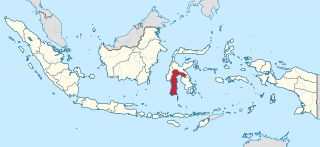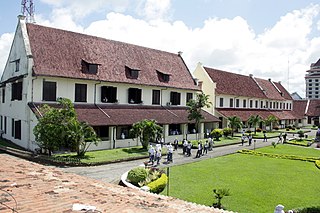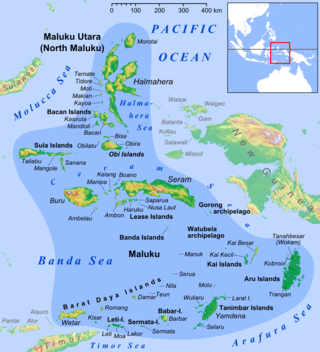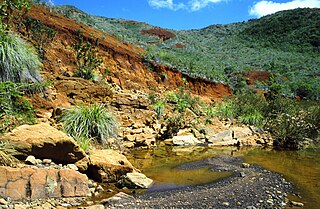
A growing population and abundant natural resources contribute to the wealth of the island of Sulawesi in Indonesia, while terrain and under-developed infrastructure limits economic growth.

A growing population and abundant natural resources contribute to the wealth of the island of Sulawesi in Indonesia, while terrain and under-developed infrastructure limits economic growth.
Sulawesi is one of the Greater Sunda Islands and the eleventh largest island in the world. The island is divided into six provinces; Gorontalo, Central Sulawesi, North Sulawesi, South Sulawesi, Southeast Sulawesi, and West Sulawesi. [1]
The geography of the island varies from region to region. The northern provinces are mountainous, while the southern provinces are lower-laying. Many provinces contain outlying islands which exhibit different economic conditions than the main island. Most economic activity on Sulawesi is conducted on a small scale, with the only notable concentrations of organized industry on the island being in Southern Sulawesi. The geography of the island disadvantages the development of industry, as much of the island's population is localized in small areas, driving up construction and labor costs. [2]
The majority of economic activity on Sulawesi is related to resource extraction, including mining, forestry, and the harvesting of other valuable natural resources. Agriculture and fishing are also major sectors of the economy. Economic activity varies from region to region, with most economic activity being centered in Southern Sulawesi and parts of Northern Sulawesi. The economic hub of the island is the province of South Sulawesi, which has the largest population of any of Sulawesi's constituent provinces and is the location of the largest city on the island, Makassar. Infrastructure on the island is sparse and limits economic development, with only Makassar having developed infrastructure. [2] Efforts to improve the island's infrastructure are ongoing, [3] notably the construction of a new port and train line in Makassar in the late 2010s. [1] In 2019 efforts began to establish a special economic zone in North Sulawesi, [4] though some locals have objected that these projects are destroying local communities and industries. [4]
Agriculture is a major component of the economy of Sulawesi and employs more people than any other economic sector—according to one 2016 source, 30–40% of Sulawesi's constituent provinces' GDP is tied to agriculture. [3] Most agriculture on the island is done on a local scale on family-owned plots, though as of the early 2010s more farmers were beginning to grow cash crops in place of the traditional rice. Crops vary by region; in the mountainous north, tree crops such as cloves, coconut, and nutmeg are grown, while in the flatter south, commercial crops such as cocoa, tobacco, sugar, and rice are grown. Cattle also contribute to the economy of Southern Sulawesi. [2]
Despite its large contribution to the economy of the island, the agricultural sector was growing slower than the Indonesian national average as of 2016. [3] Most agricultural production is highly localized and is done on small plots of land. [2]
A large part of the Sulawesi economy is based around resource extraction, most notably mining, forestry, and fishing. Being an island, Sulawesi has an extensive coastline and many of its inhabitants are involved in the fishing industry. [2]
Mining, quarrying, and other forms of mineral extraction contribute to economic activity in the island; as with other sectors of the economy, these industries are primarily concentrated in Northern and Southern Sulawesi. [2] [3] [1] Northern Sulawesi has rich copper deposits and has recently invested in building nickel smelters. [3] Chinese conglomerates Tsingshan Holding Group and Huafon Group plan to invest heavily in the island's nickel, aluminum, and chemical industries. [5]
In the late 2010s and early 2020s, the international mining industry has taken an increasing interest the Morowali Regency (located in the province of Central Sulawesi) and the region's high-quality nickel reserves - vital for the production of lithium batteries. Indonesia banned the export of nickel ore in 2014, forcing international companies to refine the ore in Indonesia and thereby increase downstream investment in Indonesian companies. The thriving nickel industry in Morowali (such as at the Morowali Industrial Park) has resulted in a large increase in the region's GDP (one source notes a 300% increase between 2013 and 2019), [6] but the expansion of the extraction industry has also caused environmental degradation. [6] As of 2021, the largest foreign investors were American, Brazilian, Chinese, and Japanese companies, while the government of Indonesia is attempting to build a domestic battery industry. [6]

The economy of the Philippines is an emerging market, a newly industrialized country and one of the most dynamic in the Asia-Pacific region. As a developing economy, the country is working towards achieving greater industrialization and economic growth. In 2023, the Philippine economy is estimated to be at ₱24.27 trillion, making it the world's 34th largest by nominal GDP and 14th largest in Asia according to the International Monetary Fund.

Sulawesi, also known as Celebes, is an island in Indonesia. One of the four Greater Sunda Islands, and the world's 11th-largest island, it is situated east of Borneo, west of the Maluku Islands, and south of Mindanao and the Sulu Archipelago. Within Indonesia, only Sumatra, Borneo, and Papua are larger in territory, and only Java and Sumatra have larger populations.

The economy of Madagascar is US$9.769 billion by gross domestic product as of 2020, being a market economy and is supported by an agricultural industry and emerging tourism, textile and mining industries. Malagasy agriculture produces tropical staple crops such as rice and cassava, as well as cash crops such as vanilla and coffee.

Central Sulawesi is a province of Indonesia located at the centre of the island of Sulawesi. The administrative capital and largest city is located in Palu. The province borders the provinces of Gorontalo to the east, Southeast Sulawesi, South Sulawesi, and West Sulawesi to the south, and sharing maritime borders with East Kalimantan to the west, North Maluku to the east, and Malaysia and the Philippines to the north. The 2010 census recorded a population of 2,635,009 for the province, and the 2020 Census recorded 2,985,734, of whom 1,534,706 were male and 1,451,028 were female. The official estimate as at mid 2022 was 3,066,143. Central Sulawesi has an area of 61,605.72 km2 (23,786 sq mi), the largest area among all provinces on Sulawesi Island, and has the second-largest population on Sulawesi Island after the province of South Sulawesi. It is bordered by the provinces of Gorontalo to the north, West Sulawesi, South Sulawesi and South East Sulawesi to the south, by Maluku to the east, and by the Makassar Strait to the west. The province is inhabited by many ethnic groups, such as the Kaili, Tolitoli, etc. The official language of the province is Indonesian, which is used for official purposes and inter-ethnic communication, while there are several indigenous language spoken by the Indigenous peoples of Central Sulawesi. Islam is the dominant religion in the province, followed by Christianity which is mostly adhered to by the people in the eastern part of the province.

South Sulawesi is a province in the southern peninsula of Sulawesi, Indonesia. The Selayar Islands archipelago to the south of Sulawesi is also part of the province. The capital and largest city is Makassar. The province is bordered by Central Sulawesi and West Sulawesi to the north, the Gulf of Bone and Southeast Sulawesi to the east, Makassar Strait to the west, and Flores Sea to the south.

Makassar, formerly Ujung Pandang, is the capital of the Indonesian province of South Sulawesi. It is the largest city in the region of Eastern Indonesia and the country's fifth-largest urban center after Jakarta, Surabaya, Medan, and Bandung. The city is located on the southwest coast of the island of Sulawesi, facing the Makassar Strait.

Palu, officially known as the City of Palu, is the capital and largest city of Central Sulawesi. Palu is located on the northwestern coast of Sulawesi and borders Donggala Regency to the north and west, Parigi Moutong Regency to the east, and Sigi Regency to the south. The city boundaries encompass a land area of 395.06 km2 (152.53 sq mi). According to the 2020 Indonesian census, Palu had a population of 373,218, making it the third-most populous city on the island after Makassar and Manado; the official estimate as at mid 2022 was 381,572 - comprising 191,052 males and 190,520 females. Palu is the center of finance, government, and education in Central Sulawesi, as well as one of several major cities on the island. The city hosts the province's main port, its biggest airport, and most of its public universities.

The Economy of the Empire of Japan refers to the period in Japanese economic history in Imperial Japan that began with the Meiji Restoration in 1868 and ended with the Surrender of Japan in 1945 at the end of World War II. It was characterized by a period of rapid industrialization in the late nineteenth and early twentieth centuries, and the dominance of a wartime economy from 1938–1945.

The Obi Islands are a group of 42 islands in the Indonesian province of North Maluku, north of Buru and Ceram, and south of Halmahera. With a total area of 3,048.08 km2, they had a population of 41,455 at the 2010 Census and 50,760 at the 2020 Census. The official estimate as at mid 2022 was 52,588.

The Western Australian economy is a state economy dominated by its resources and services sector and largely driven by the export of iron-ore, gold, liquefied natural gas and agricultural commodities such as wheat. Covering an area of 2.5 million km2, the state is Australia's largest, accounting for almost one-third of the continent. Western Australia is the nation's fourth most populous state, with 2.6 million inhabitants.

Agriculture in Indonesia is one of the key sectors within the Indonesian economy. In the last 50 years, the sector's share in national gross domestic product has decreased considerably, due to the rise of industrialisation and service sector. Nevertheless, for the majority of Indonesian households, farming and plantation remains as a vital income generator. In 2013, the agricultural sector contributed 14.43% to national GDP, a slight decline from 2003's contribution which was 15.19%. In 2012, the agricultural sector provides jobs to approximately 49 million Indonesians, representing 41% of the country's total labor force.

Nickel mining in New Caledonia is a major sector of the New Caledonian economy. The island contains about 7.1 million tonnes of nickel reserves, about 10% of the world's total. With an annual production of 200,000 tonnes in 2020, New Caledonia was the world's fourth largest producer after Indonesia (760,000), Philippines (320,000), and Russia (280,000), followed by Australia (170,000) and Canada (150,000).

Sidenreng Rappang Regency is a landlocked regency of South Sulawesi Province in Indonesia. It has an area of 1,883.25 kilometres (1,170.20 mi) and had a population of 271,911 at the 2010 Census and 319,990 at the 2020 Census; the official estimate as at mid 2022 was 327,416. Its capital is at the town of Pangkajene Sidenreng. The original inhabitants of this area are Bugis.

Morowali Regency is a regency of Central Sulawesi Province of Indonesia. It covers an area of 5,472 km2 and the districts now within the regency had a combined population of 102,228 at the 2010 Census; the regency population at the 2020 Census was 161,727; the official estimate as at mid 2022 was 176,244. The administrative centre is at the town of Bungku. The Regency includes the far-flung Menui Islands, lying to the southwest of the rest of the province.

The Greater Sunda Islands are four tropical islands situated within the Indonesian Archipelago, in the Pacific Ocean. The islands, Borneo, Java, Sulawesi and Sumatra, are internationally recognised for their ecological diversity and rich culture. Together with the Lesser Sunda Islands to their southeast, they comprise the archipelago known as the Sunda Islands.

Nickel mining in Indonesia began with small-scale exploratory mining operations during the Dutch East Indies era and began to expand in the 1960s. Most of Indonesia's proven nickel reserves are located in the islands of Sulawesi and Halmahera, and the country has the largest annual production and reserves of nickel in the world.


The Tsingshan Holdings Group is a Chinese private company active in the stainless steel and nickel industry.
Bintang Delapan Group is one of the largest mining companies based in Indonesia. It mines minerals and smelts metals in Indonesia, the Solomon Islands and Myanmar, and partly owns the Indonesia Morowali Industrial Park.

The Sulawesi Canal, also known as Equatorial Canal, refers to proposals for a canal on the island of Sulawesi, connecting the Gulf of Tomini with the Makassar Strait, with the aim of becoming a busy international sea route that will shorten the sea transport distance from the eastern part of Sulawesi Island to the western part of Indonesia, as well as to the Philippines and Malaysia.